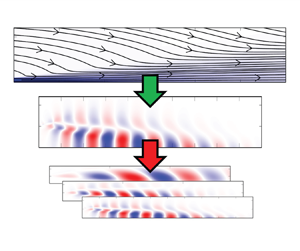No CrossRef data available.
Published online by Cambridge University Press: 27 November 2024

This study presents an approach to investigate the role of eddy viscosity in linearized mean-field analysis of broadband turbulent flows. The procedure is based on spectral proper orthogonal decomposition (SPOD), resolvent analysis and the energy budget of coherent structures and is demonstrated using the example of a turbulent jet. The focus is on the coherent component of the Reynolds stresses, the nonlinear interaction term of the fluctuating velocity component in frequency space, which appears as an unknown in the derivation of the linearized Navier–Stokes equations and which is the quantity modelled by the Boussinesq approach. For the considered jet the coherent Reynolds stresses are found to have a mostly dissipative effect on the energy budget of the dominant coherent structures. Comparison of the energy budgets of SPOD and resolvent modes demonstrates that dissipation caused by nonlinear energy transfer must be explicitly considered within the linear operator to achieve satisfactory results with resolvent analysis. Non-modelled dissipation distorts the energy balance of the resolvent modes and is not, as often assumed, compensated for by the resolvent forcing vector. A comprehensive analysis, considering different predictive and data-driven eddy viscosities, demonstrates that the Boussinesq model is highly suitable for modelling the dissipation caused by nonlinear energy transfer for the considered flow. Suitable eddy viscosities are analysed with regard to their frequency, azimuthal wavenumber and spatial dependence. In conclusion, the energetic considerations reveal that the role of eddy viscosity is to ensure that the energy the structures receive from the mean-field is dissipated.